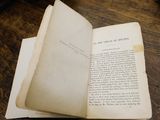How Many Natural Selection Drives Changes In Genetic Makeup Of A Population
English naturalist Charles Darwin developed the thought of natural selection after a 5-yr voyage to study plants, animals, and fossils in South America and on islands in the Pacific. In 1859, he brought the idea of natural selection to the attention of the globe in his best-selling volume, On the Origin of Species. Natural selection is the process through which populations of living organisms suit and change. Individuals in a population are naturally variable, meaning that they are all different in some means. This variation ways that some individuals have traits better suited to the environment than others. Individuals with adaptive traits—traits that requite them some advantage—are more than likely to survive and reproduce. These individuals and so pass the adaptive traits on to their offspring. Over time, these advantageous traits become more mutual in the population. Through this procedure of natural selection, favorable traits are transmitted through generations. Natural option can lead to speciation, where 1 species gives rise to a new and distinctly different species. It is 1 of the processes that drives evolution and helps to explicate the diversity of life on World. Darwin chose the name natural option to contrast with "artificial selection," or selective breeding that is controlled by humans. He pointed to the pastime of pigeon convenance, a pop hobby in his day, as an example of artificial selection. Past choosing which pigeons mated with others, hobbyists created singled-out pigeon breeds, with fancy feathers or acrobatic flying, that were dissimilar from wild pigeons. Darwin and other scientists of his day argued that a process much like artificial selection happened in nature, without whatever human intervention. He argued that natural selection explained how a broad variety of life forms adult over time from a single common antecedent. Darwin did not know that genes existed, simply he could come across that many traits are heritable—passed from parents to offspring. Mutations are changes in the structure of the molecules that brand upward genes, called DNA. The mutation of genes is an important source of genetic variation within a population. Mutations tin can be random (for example, when replicating cells make an mistake while copying DNA), or happen as a result of exposure to something in the surround, like harmful chemicals or radiation. Mutations can exist harmful, neutral, or sometimes helpful, resulting in a new, advantageous trait. When mutations occur in germ cells (eggs and sperm), they can exist passed on to offspring. If the surround changes speedily, some species may not be able to adjust fast enough through natural choice. Through studying the fossil tape, we know that many of the organisms that once lived on Globe are now extinct. Dinosaurs are 1 example. An invasive species, a disease organism, a catastrophic environmental modify, or a highly successful predator can all contribute to the extinction of species. Today, homo actions such equally overhunting and the destruction of habitats are the main cause of extinctions. Extinctions seem to be occurring at a much faster rate today than they did in the past, as shown in the fossil record.

English naturalist Charles Darwin wrote the definitive book outlining his idea of natural selection, On the Origin of Species. The book chronicled his studies in South America and Pacific islands. Published in 1859, the book became a best seller.
Photograph by Ian Forsyth via Getty Images
adapt
Verb
to accommodate to new surround or a new situation.
DNA
Noun
(deoxyribonucleic acrid) molecule in every living organism that contains specific genetic information on that organism.
evolution
Noun
change in heritable traits of a population over time.
Noun
process of complete disappearance of a species from Earth.
factor
Substantive
function of DNA that is the basic unit of measurement of heredity.
genetic
Adjective
having to do with genes, inherited characteristics or heredity.
Substantive
type of plant or beast that is not indigenous to a particular area and causes economic or environmental damage.
molecule
Substantive
smallest physical unit of a substance, consisting of two or more atoms linked together.
Noun
sudden variation in one or more than characteristics acquired past a change in a gene or chromosome.
Noun
process by which organisms that are amend -adapted to their environments produce more offspring to transmit their genetic characteristics.
predator
Noun
fauna that hunts other animals for food.
Noun
process by which ane or more populations of a species go genetically different enough to class a new species.
Noun
group of similar organisms that tin reproduce with each other.
trait
Noun
characteristic or aspect.
variation
Noun
difference.
Source: https://www.nationalgeographic.org/encyclopedia/natural-selection/
Posted by: solomonthants.blogspot.com


0 Response to "How Many Natural Selection Drives Changes In Genetic Makeup Of A Population"
Post a Comment